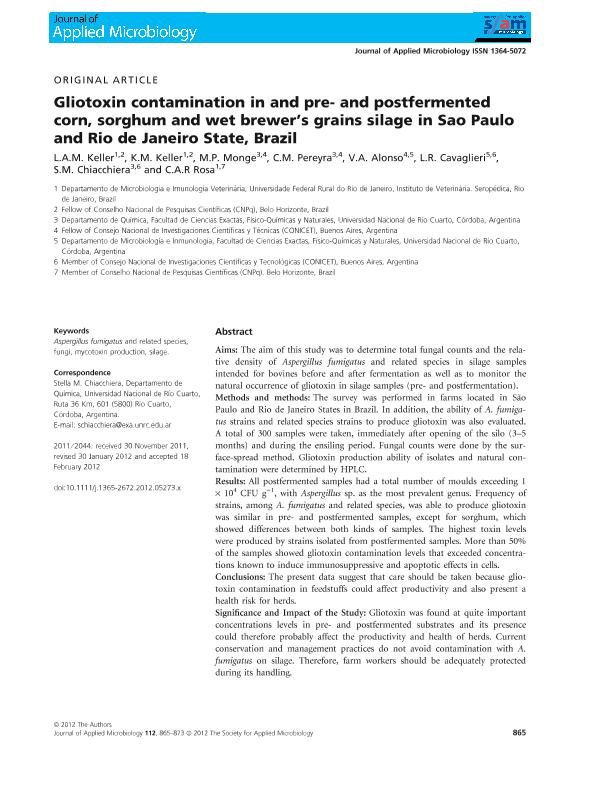Artículo
Gliotoxin contamination in and pre- and postfermented corn, sorghum and wet brewer’s grains silage in Sao Paulo and Rio de Janeiro State, Brazil
Keller, Luiz Antonio Moura; Keller, Kelly Moura; Monge, Maria del Pilar ; Pereyra, Carina Maricel
; Pereyra, Carina Maricel ; Alonso, Veronica Andrea
; Alonso, Veronica Andrea ; Cavaglieri, Lilia Reneé
; Cavaglieri, Lilia Reneé ; Chiacchiera, Stella Maris
; Chiacchiera, Stella Maris ; R Rosa, C. A.
; R Rosa, C. A.
 ; Pereyra, Carina Maricel
; Pereyra, Carina Maricel ; Alonso, Veronica Andrea
; Alonso, Veronica Andrea ; Cavaglieri, Lilia Reneé
; Cavaglieri, Lilia Reneé ; Chiacchiera, Stella Maris
; Chiacchiera, Stella Maris ; R Rosa, C. A.
; R Rosa, C. A.
Fecha de publicación:
05/2012
Editorial:
Wiley Blackwell Publishing, Inc
Revista:
Journal of Applied Microbiology
ISSN:
1364-5072
e-ISSN:
1365-2672
Idioma:
Inglés
Tipo de recurso:
Artículo publicado
Clasificación temática:
Resumen
The aim of this study was to determine total fungal counts and the relative density of Aspergillus fumigatus and related species in silage samples intended for bovines before and after fermentation as well as to monitor the natural occurrence of gliotoxin in silage samples (pre- and postfermentation). Methods and methods: The survey was performed in farms located in São Paulo and Rio de Janeiro States in Brazil. In addition, the ability of A. fumigatus strains and related species strains to produce gliotoxin was also evaluated. A total of 300 samples were taken, immediately after opening of the silo (3-5 months) and during the ensiling period. Fungal counts were done by the surface-spread method. Gliotoxin production ability of isolates and natural contamination were determined by HPLC. Results: All postfermented samples had a total number of moulds exceeding 1 × 10 4 CFU g -1, with Aspergillus sp. as the most prevalent genus. Frequency of strains, among A. fumigatus and related species, was able to produce gliotoxin was similar in pre- and postfermented samples, except for sorghum, which showed differences between both kinds of samples. The highest toxin levels were produced by strains isolated from postfermented samples. More than 50% of the samples showed gliotoxin contamination levels that exceeded concentrations known to induce immunosuppressive and apoptotic effects in cells. Conclusions: The present data suggest that care should be taken because gliotoxin contamination in feedstuffs could affect productivity and also present a health risk for herds. Significance and Impact of the Study: Gliotoxin was found at quite important concentrations levels in pre- and postfermented substrates and its presence could therefore probably affect the productivity and health of herds. Current conservation and management practices do not avoid contamination with A. fumigatus on silage. Therefore, farm workers should be adequately protected during its handling.
Archivos asociados
Licencia
Identificadores
Colecciones
Articulos(CCT - CORDOBA)
Articulos de CTRO.CIENTIFICO TECNOL.CONICET - CORDOBA
Articulos de CTRO.CIENTIFICO TECNOL.CONICET - CORDOBA
Citación
Keller, Luiz Antonio Moura; Keller, Kelly Moura; Monge, Maria del Pilar; Pereyra, Carina Maricel; Alonso, Veronica Andrea; et al.; Gliotoxin contamination in and pre- and postfermented corn, sorghum and wet brewer’s grains silage in Sao Paulo and Rio de Janeiro State, Brazil; Wiley Blackwell Publishing, Inc; Journal of Applied Microbiology; 112; 5; 5-2012; 865-873
Compartir
Altmétricas



